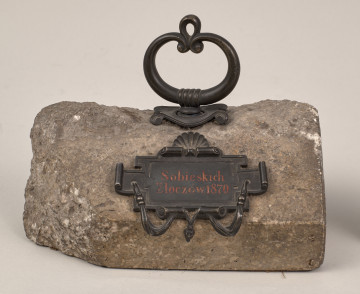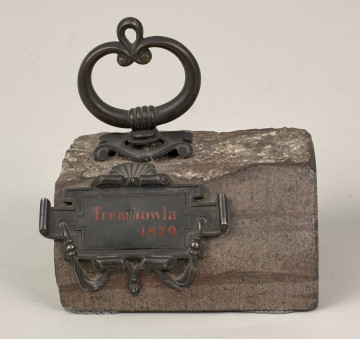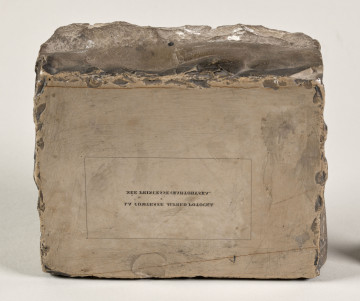
Paperweight
XIX century
Castle Museum in Łańcut
Part of the collection: Weapons, music instruments, varia
Human memory is unreliable, it is better to write down your thoughts so that they do not fly away. Writing is an art that is one of the milestones of human civilization.
All you need to write is a blank sheet of paper, a pen, ink (increasingly replaced by word processors, mice, etc.) and you can create the next national epic. To make it not too easy, the ink stains the sheets of paper, stains the fingers, but tissue paper can remedy this. Once we have dealt with the ink and stains, we sit down and "pour" our thoughts onto paper. We're sitting, we're writing with enthusiasm, and then someone walks in the room, opens the door, opens the window, and this treacherous wind blows the written and unwritten pages to the floor, mixing everything up. The poor creator had to pick them up, often on his knees, and his back hurts from sitting. When he has already collected the pages, it turns out that they are mixed up, and he forgot to number them and, to make matters worse, a few pages were forgotten during the collection and in fact they should be rewritten. Finally, we manage to put the written pages in order and we sit down to continue our work, and then someone comes in again on an urgent matter, someone opens the second window and again we have confetti from our written pages and we start collecting our written "golden thoughts" from the beginning. After a few such visits, we forget our own thoughts, discouragement creeps in, and because of such a small zephyr, some "epoch-making" work may not be created. And yet it was enough (with the exception of locking the doors and windows) to hold the blank and written pages with some heavy object, but not so heavy as to destroy the sheets of paper. Such an object is a paperweight, which is sometimes a small work of art in the form of a figurine, a plaque made of alabaster or glass, or other materials that are pleasing to the eye. They can also be very simple elements, such as various types of stones collected during trips to places sentimentally close to the collectors or related to the history of family or country. In this way, the paperweight became an indispensable desk equipment next to the inkwell, pounce pot, tissue paper, pen holder, lamp, and just like them, it took on different forms and shapes depending on the fashion prevailing in art at a given period. Paperweights, thanks to their form/shape and the material they are made of, complement the décor of the desk – those made of wood evoke the impression of warmth, those made of metal, especially precious metals, add majesty, and those made of glass or crystal, thanks to reflections, give the character of ephemerality like written thoughts. The most ordinary ones in the form of stones remind us of the places we have been to. They can also remind us of past centuries and events that determine our history and heritage.
The discussed paperweights from the collection of the Museum – Castle in Łańcut come from the collection of the Potocki family, belong to the latter category and come from places currently outside the country (Borderlands) related to the history of Poland. One of them is the paperweight with the inv. No. S.4488MŁ. It is in the shape of a lying stone irregular cuboid with irregular edges, on the top it has a round brass plate made of the same material, decorated with a shell motif and attached to a stone without visible studs with the inscription "Zamek krzemieniecki-1871” (Krzemieniec Castle – 1871"). Like most of the towns and castles of the former south-eastern Polish, now called Eastern Borderlands, it is closely related to the history and history of our homeland. The history of the castle dates back to the first half of the thirteenth century. According to the chronicle from 1227, under the castle the army of the prince of Galicia-Volhynia Mścisława II Udała defeated in 1226 the forces of the Hungarian king Andrew II. Fourteen years later (1240) the Krzemieniec Castle was the only one in the Kingdom of Galicia–Volhynia that successfully resisted (was not conquered) by the Mongol army of Batu Khan. Over 120 years later, on the order of King Kazimerz Wielki, the Castle was garrisoned with Polish armed personnel and officials, and its owner (as the king's fiefdom) was appointed Jerzy Narymuntowicz. Temporarily, after the death of Kazimierz Wielki, the castle became part of the Hungarian estate, but around 1380 it became part of Lithuania. In the years 1409 – 1418, Svidrigailo, a cousin of the Grand Duke Vytautas, was imprisoned in the castle (punishment for allying with the Teutonic Order during the Great War). In 1431, the former prisoner Prince Svidrigailo granted the town the Magdeburg Law and established Krzemieniec the seat of the district governor of the Volhynia Land of the Grand Duchy of Lithuania. The heyday of the castle and Krzemieniec began in 1536, when the district of Krzemieniec became the property of Queen Bona. On the initiative of the new owner, many reconstructions were carried out, the castle erected on the top of a steep mountain (Bona Mountain) received a Renaissance appearance. The walls and earth fortifications were strengthened, and in the following years its artillery was gradually strengthened. The heyday of the castle ended with the capture and destruction of it after a six-week siege by the Cossack army commanded by Colonel Maxim Krzywonos (you can meet him in the pages of "With Fire and Sword"). The castle was never rebuilt and remained to this day a picturesque ruin towering over the town, and Krzemieniec itself experienced the same events as all the towns of the Borderlands – it was not spared the repressions of the invaders, wars (World War I, Polish-Bolshevik War, World War II) and post-war times.
Przemysław Kucia
Author / creator
Object type
pamiątki
Material
stone
Creation / finding place
Owner
Muzeum - Zamek w Łańcucie
Identification number
Location / status

XIX century
Castle Museum in Łańcut

XIX century
Castle Museum in Łańcut

XIX century
Castle Museum in Łańcut
DISCOVER this TOPIC
Museum of King Jan III's Palace at Wilanów
DISCOVER this PATH
Educational path